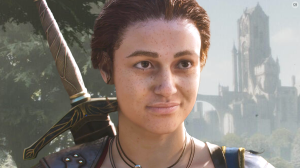
PokeNatomy is an unofficial guide to the complex biology of the first generation of Pokemon, and the creator of the book, Christopher Stoll, recently spoke with us about his creative process and experiences with the guide.
Videos by ComicBook.com
Stoll’s project began on Kickstarter with plenty of backers, and now fully completed, PokeNatomy can be purchased here in a variety of editions from a digital edition to a leather-bound book. At the end of the interview, there’s a chance for one lucky reader to win a signed copy of Stoll’s PokeNatomy in a special ComicBook.com giveaway, so stick around. Let’s dive in!
CB: From all the routes you could’ve taken, why a Pokemon anatomy book?
CS: That’s an excellent question. I actually studied biology and veterinary science when I was in school and always had this really intense love for the natural world and for science. When I was 10 years old, Pokemon came to the states, and so I was right at ground zero during that big first cultural wave and was a fan from day one. So, when it came time to do some of my own art, I wanted to combine my love of science with something that I knew other people could relate to and a fandom that meant a great deal to me.
With starting the project on Kickstarter, did having the Pokemon name attached to it help or hinder your book?
It’s hard to say. I think that the cultural footprint of Pokemon helps pique people’s interest, but also raises their resistance to it and makes them a little more skeptical. They’ll ask questions like “Is this person going to be respectful of the canon, are they going to do something that will be legally acceptable, have they done all the legwork necessary to make sure their project is suitably researched?” So, while it might bring more attention, I think it can also reduce pledges by making people a little more critical than [they would be] towards a totally new intellectual project.

Speaking of staying true to the canon, how did you even begin researching the biology of Pokemon, especially stranger, less animalistic ones?
With some of them, it was a little easier because there were some things built into the lore right from the start that I could use as a base to design the anatomy and delve into the science of them. For example, Cubone in the stories is this Pokemon that wears the skull of its family members as a sort of armor. When looking into that, you have to come up with a natural rationale for that cartoony, bizarre, behavior. I started looking through my biology books and searching the Internet for some sort of parallel for creatures that use biological artifacts for a kind of armor and eventually settled on hermit crabs. I sort of mapped the behavior of hermit crabs onto Cubone and their treatment of these skulls, a limited resource.
Were there any Pokemon that you ran into issues with when using that method?
The Psychic Pokemon, in particular, were difficult. I wanted the book to be scientific, and some Pokemon have clear counterparts in the animal kingdom. But with some of the more fanciful Pokemon, some of the mechanical or psychic ones, I had to try to excuse or explain these crazy powers in ways that weren’t totally ridiculous.
When you decided to take the biology textbook angle for PokeNatomy, were there any specific audiences that you had in mind or even some that you thought might not enjoy the book?
Right from the start, it was difficult to balance the different audience I had. During the Kickstarter period, I had parents of kids who just loved Pokemon who wanted something like a scientific book with pretty pictures in it to show them, but on the end of the spectrum, I had medical students and even doctors or veterinarians who really wanted to see fidelity to the science and interesting biological concepts explored. The whole project was sort of pinging back and forth between these two audiences to make it accessible to a 13-year-old in their room but also interesting to a 27-year-old medical student.

Sometimes people take the hyper-realistic route with drawing Pokemon, but you chose not to. Tell me a bit about what your intentions were for your illustrations.
I think the “realistic Pokemon” thing is maybe a big overplayed at this point. I’ve seen hundreds and hundreds of beautiful Pikachu and Charizard as really realistic organisms, more like monsters. For a while, it seemed like it was very popular on the Internet to illustrate Pokemon as realistic or horrifying, but by the time I started my project, that trend had already come and gone, so I wanted to do it a bit differently. So, I tried to draw the actual Pokemon in a very cartoony way to keep their proportions exactly as they appear in the anime or the games. Big wide eyes, tiny little mouths, and to use that cartoony style to explore the impossible underlying anatomy and make these cute characters grotesque and bizarre to capture people’s attention that way.
With the first generation of Pokemon completed, do you have any plans for future Pokemon projects?
I would be interested to continue pursuing Pokemon projects. I think this project was very well received, and if I end up doing another one, it won’t be my next project. If I do a Vol. 2, it’ll be after my next project. I don’t know if I could handle doing another Pokemon book right away, but I do enjoy the subject.








